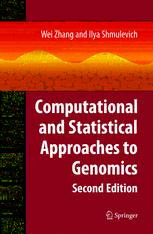Table Of ContentCOMPUTATIONAL AND
STATISTICAL APPROACHES TO
GENOMICS, SECOND EDITION
COMPUTATIONAL AND
STATISTICAL APPROACHES TO
GENOMICS, SECOND EDITION
editedby
Wei Zhang
University of Texas, M.D. Anderson Cancer Center
and
Ilya Shmulevich
Institute for Systems Biology, Seattle, WA
LibraryofCongressCataloging-in-PublicationData
Computationalandstatisticalapproachestogenomics/editedbyWeiZhang
andIlyaShmulevich.–2nded.
p.cm.
Includesbibliographicalreferencesandindex.
ISBN-13:978-0-387-26287-1
ISBN-10:0-387-26287-3(alk.paper)
ISBN-13:978-0-387-26288-8(e-book)
ISBN-10:0-387-26288-1(e-book)
1.Genomics—Mathematicalmodels.2.Genomics—Statistical
methods.3Genomics—Dataprocessing.4DNAmicroarrays.I.Zhang,
Wei,1963-II.Shmulevich,Ilya,1969-
QH438.4.M3C652005
572.8’6’015118—dc22 2005049761
(cid:2)c 2006SpringerScience+BusinessMedia,Inc.
All rights reserved. This work may not be translated or copied in whole or in part
without the written permission of the publisher (Springer Science+Business Media,
Inc., 233 Spring Street, New York, NY 10013, USA), except for brief excerpts in
connection with reviews or scholarly analysis. Use in connection with any form of
information storage and retrieval, electronic adaptation, computer software, or by
similarordissimilarmethodologynowknownorhereafterdevelopedisforbidden.
The use in this publication of trade names, trademarks, service marks and similar
terms, even if they are not identified as such, is not to be taken as an expression of
opinionastowhetherornottheyaresubjecttoproprietaryrights.
PrintedintheUnitedStatesofAmerica.
9 8 7 6 5 4 3 2 1 SPIN11419631
springeronline.com
Thisbookisdedicated
toourfamiliesand
colleagues
Contents
Preface ix
1
MicroarrayImageAnalysisandGeneExpressionRatioStatistics 1
Yidong Chen, Edward R. Dougherty, Michael L. Bittner, Paul Meltzer, and
JefferyTrent
2
Statistical Considerations in the Assessment of cDNA Microarray Data 21
ObtainedUsingAmplification
JingWang,KevinR.Coombes,KeithBaggerly,LimeiHu,
StanleyR.Hamilton,andWeiZhang
3
SourcesofVariationinMicroarrayExperiments 37
KathleenF.Kerr,EdwardH.Leiter,LaurentPicard,andGaryA.Churchill
4
StudentizingMicroarrayData 49
Keith A. Baggerly, Kevin R. Coombes, Kenneth R. Hess, David N. Stivers,
LynneV.Abruzzo,andWeiZhang
5
ExploratoryClusteringofGeneExpressionProfilesofMutatedYeastStrains 61
Merja Oja, Janne Nikkila¨, Petri To¨ro¨nen, Garry Wong, Eero Castre´n, and
SamuelKaski
6
SelectingInformativeGenesforCancerClassificationUsingGene 75
ExpressionData
TatsuyaAkutsuandSatoruMiyano
7
Finding Functional Structures in Glioma Gene-Expressions Using Gene 89
ShavingClusteringandMDLPrinciple
Ciprian D. Giurcaneanu, Cristian Mircean, Gregory N. Fuller, and
IoanTabus
viii Contents
8
DesignIssuesandComparisonofMethodsforMicroarray-Based 119
Classification
EdwardR.DoughertyandSanjuN.Attoor
9
AnalyzingProteinSequencesUsingSignalAnalysisTechniques 137
KarenM.BlochandGonzaloR.Arce
10
Scale-Dependent Statistics of the Numbers of Transcripts and Protein 163
SequencesEncodedintheGenome
VladimirA.Kuznetsov
11
StatisticalMethodsinSerialAnalysisofGeneExpression(SAGE) 209
RicardoZ.N.VeˆncioandHelenaBrentani
12
NormalizedMaximumLikelihoodModelsforBooleanRegressionwith 235
ApplicationtoPredictionandClassificationinGenomics
IoanTabus,JormaRissanen,andJaakkoAstola
13
InferenceofGeneticRegulatoryNetworksviaBest-FitExtensions 259
HarriLa¨hdesma¨ki,IlyaShmulevich,OlliYli-Harja,andJaakkoAstola
14
RegularizationandNoiseInjectionforImprovingGeneticNetworkModels 279
EugenevanSomeren,LodewykWessels,MarcelReinders,andEricBacker
15
ParallelComputationandVisualizationToolsforCodeterminationAnalysis 297
ofMultivariateGeneExpressionRelations
EdwardB.Suh,EdwardR.Dougherty,SeungchanKim,MichaelL.Bittner,
YidongChen,DanielE.Russ,andRobertL.Martino
16
SingleNucleotidePolymorphismsandTheirApplications 311
RudyGuerraandZhaoxiaYu
17
The Contribution of Alternative Transcription and Alternative Splicing to 351
theComplexityofMammalianTranscriptomes
MihaelaZavolanandChristianScho¨nbach
18
Computational Imaging, and Statistical Analysis of Tissue Microarrays: 381
QuantitativeAutomatedAnalysisofTissueMicroarrays
AaronJ.Berger,RobertL.Camp,andDavidL.Rimm
Index 405
Preface
During the three years after the publication of the first edition of this
book,thecomputationalandstatisticalresearchingenomicshavebecome
increasingly more important and indispensable for understanding cellular
behaviorunderavarietyofenvironmentalconditionsandfortacklingchal-
lenging clinical problems. In the first edition, the organizational structure
was:data → analysis → synthesis → application.Inthesecondedition,
wehavekeptthesamestructurebuthavedecidedtoeliminatechaptersthat
primarilyfocusedonapplications.
Ourdecisionwasmotivatedbyseveralfactors.Firstly,themainfocusof
thisbookiscomputationalandstatisticalapproachesingenomicsresearch.
Thus, the main emphasis is on methods rather than on applications.
Secondly, many of the chapters already include numerous examples of
applicationsofthediscussedmethodstocurrentproblemsinbiology.
We have tried to further broaden the range of topics to which end we
have included newly contributed chapters on topics such as alternative
splicing,tissuemicroarrayimageanddataanalysis,singlenucleotidepoly-
morphisms, serial analysis of gene expression, and gene shaving.
Additionally,anumberofchaptershavebeenupdatedorrevised.Wethank
allthecontributingauthorsfortheircontributionsandhopethatyouenjoy
readingthisbook.
WeiZhang
Houston,TX
IlyaShmulevich
Seattle,WA
Chapter 1
MICROARRAY IMAGE ANALYSIS AND GENE
EXPRESSION RATIO STATISTICS
Yidong Chen1, Edward R. Dougherty2, Michael L. Bittner1, Paul Meltzer1,
andJefferyTrent1
1CancerGeneticsBranch,NationalHumanGenomeResearchInstitute,NationalInstitutesof
Health,Bethesda,Maryland,USA
2DepartmentofElectricalEngineering,TexasA&MUniversity,CollegeStation,Texas,USA
1. Introduction
A cell relies on its protein components for a wide variety of its functions,
includingenergyproduction,biosynthesisofcomponentmacro-molecules,
maintenance of cellular architecture, and the ability to act upon intra-
and extra-cellular stimuli. Each cell in an organism contains the informa-
tion necessary to produce the entire repertoire of proteins the organism
can specify. Since a cell’s specific functionality is largely determined by
the genes it is expressing, it is logical that transcription, the first step in
the process of converting the genetic information stored in an organism’s
genome into protein, would be highly regulated by the control network
thatcoordinatesanddirectscellularactivity.Aprimarymeansforregulat-
ing cellular activity is the control of protein production via the amounts
of mRNA expressed by individual genes. The tools required to build an
understanding of genomic regulation of expression reveal the probability
characteristicsoftheseexpressionlevels.
Complementary DNA microarray technology provides a powerful ana-
lyticaltoolforhumangeneticresearch(Schenaetal.,1995;Schenaetal.,
1996;DeRisietal.,1996;DeRisietal.,1997;Dugganetal.,1999).Itcom-
bines robotic spotting of small amounts of individual, pure nucleic acid
speciesonaglasssurface,hybridizationtothisarraywithmultiplefluores-
centlylabelednucleicacids,anddetectionandquantitationoftheresulting
fluor-taggedhybridswithascanningconfocalmicroscope(Fig.1.1).Aba-
sicapplicationisquantitativeanalysisoffluorescencesignalsrepresenting
2 COMPUTATIONALGENOMICS
clones in Photomultiplier Tube
96-well plates
PMT
Red channel
Infected Uninfected
Cells Cells
Barrier filter
Reverse
Transcription PMT Green channel
Label with Dichroic mirror
Fluor Dyes Pinhole
PCR Amplification Excitation Lasers
DNA Purification Barrier filter Laser
Laser
UV-crosslink Hybridize Laser
Rproinbtointigc BDleoncaktinugre pmriocbroea troray Objective Eanxaplryessission
X-Y stage
Poly-L-Lysine Red probe
coated glass slide Green probe Array
Database
Microarray cDNA Probe Confocal Computer
Preparation Hybridization Microscope Analysis
Figure1.1. Illustrationofamicroarraysystem.
the relative abundance of mRNA from distinct tissue samples. cDNA mi-
croarraysarepreparedbyprintingthousandsofcDNAsinanarrayformat
onglassmicroscopeslides,whichprovidegene-specifichybridizationtar-
gets.DistinctmRNAsamplescanbelabeledwithdifferentfluorsandthen
co-hybridized on to each arrayed gene. Ratios of gene-expression levels
between the samples can be used to detect meaningfully different expres-
sionlevelsbetweenthesamplesforagivengene.Givenanexperimentde-
sign with multiple tissue samples, microarray data can be used to cluster
genesbasedonexpressionprofiles(Eisenetal.,1998;Khan et al.,1998),
tocharacterizeandclassifydiseasebasedtheexpressionlevelsofgenesets
(Golub et al., 1999; Ben-Dor et al., 2000; Bittner et al., 2000; Hedenfalk
et al., 2001; Khan et al., 2001), and for the many statistical methods pre-
sented in this book. When using cDNA microarrays, the signal must be
extracted from the background. This requires image processing to extract
signalsarisingfromtaggedmRNAhybridizedtoarrayedcDNAlocations
(Chen et al., 1997; Schadt et al., 2000; Kim et al., 2001), and variability
analysisandmeasurementqualitycontrolassessment(Bittneretal.,2001;
Newtonetal.,2001;Wangetal.,2001).
This chapter discusses an image processing environment whose com-
ponents have been specially designed for cDNA microarrays. It measures
signalsandratiostatisticstodeterminewhetheraratioissignificantlyhigh
orlowinordertoconcludewhetherthegeneisup-ordown-regulated,and
providesrelatedtoolssuchasthoseforqualityassessment.
MicroarrayImageAnalysisandRatioStatistics 3
2. Microarray Image Analysis
A typical glass-substrate and fluorescent-based cDNA microarray detec-
tionsystemisbasedonascanningconfocalmicroscope,wheretwomono-
chrome images are obtained from laser excitations at two different
wavelengths. Monochrome images of the fluorescent intensity for each
fluorarecombinedbyplacingeachimageintheappropriatecolorchannel
ofanRGBimage(Fig.1.2).Inthiscompositeimage,onecanvisualizethe
differentialexpressionofgenesinthetwocelltypes:testsampletypically
placed in red channel, while the reference sample in green channel. In-
tenseredfluorescenceataspotindicatesahighlevelofexpressionofthat
geneinthetestsamplewithlittleexpressioninthereferencesample.Con-
versely,intensegreenfluorescenceatspotindicatesrelativelylowexpres-
sionofthatgeneinthetestsamplecomparedtothereference.Whenboth
testandreferencesamplesexpressageneatsimilarlevels,theobservedar-
ray spot is yellow. We generally assume that specific DNA products from
twosampleshaveanequalprobabilityofhybridizingtothespecifictarget.
Thus, the fluorescent intensity measurement is a function of the amount
ofspecificRNAavailablewithineachsample,providedsamplesarewell-
mixed and there is sufficiently abundant cDNA deposited at each target
location.
Theobjectiveofthemicroarrayimageanalysisistoextractprobeinten-
sities or ratios at each cDNA target location, and then cross-link printed
clone information so that biologists can easily interpret the outcomes
and perform further high-level analysis. The block diagram of the im-
age analysis system is shown in Fig. 1.3. A microarray image is first seg-
mented into individual cDNA targets, either by manual interaction or an
Figure1.2. Anexampleofmicroarrayimage.

